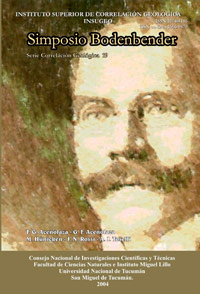Serie Correlación Geológica 19
Geología de los Granitos Huaco y Sanagasta, Sector Centro-Oriental de la Sierra de Velasco, La Rioja
Pablo Grosse | Fernando G. Sardi
Descargar trabajo en formato PDFResumen
LOS GRANITOS HUACO Y SANAGASTA AFLORAN ENEL SECTOR CENTRO-ORIENTAL DE LA SIERRA DE VELASCO. Corresponden a dos cuerpos semi-elipsoidales contiguos y con contactos transicionales intruidos en granitoides deformados (el Ortogneis Antinaco) hacia el oeste y filitas correspondientes a la Formación La Cébila hacia el este. Ambos granitos consisten en sieno a monzogranitos porfíricos biotíticos de grano grueso. El Granito Sanagasta se diferencia por la coloración rosada de sus megacristales de microclino, la casi total ausencia de muscovita y la presencia de microclino manteado. Los granitos contienen enclaves magmáticos máficos y félsicos y son intruidos por pequeños cuerpos graníticos equigranulares. Ambos granitos se encuentran asociados a pegmatitas berilíferas y el granito Huaco contiene pequeños afloramientos de rocas orbiculares. Mediciones de susceptibilidad magnética revelan que los granitos corresponden a la serie de ilmenita mientras que la geoquímica del Granito Huaco indica una tendencia peraluminosa a fuertemente peraluminosa y una concentración alta en potasio y en elementos trazas incompatibles. La ausencia de deformación y las relaciones con las rocas encajantes indican que los granitos Huaco y Sanagasta son posteriores a la deformación del Ortogneis Antinaco, estimando sus edades entre el Devónico inferior y el Carbonífero medio. Las estructuras internas y las rocas de caja sugieren que los granitos se emplazaron en niveles someros mediante mecanismos pasivos en un ambiente extensional posiblemente relacionado a una etapa post-colisional. Los datos mineralógicos y geoquímicos, así como la frecuencia y tipo de pegmatitas asociadas, sugieren una afinidad con granitos tipo S. Los granitos Huaco y Sanagasta corresponderían a un importante evento magmático post-tectónico ocurrido durante el Paleozoico medio que podría relacionarse con otros granitos Devónicos y Carboníferos en diversos sectores de las Sierras Pampeanas Noroccidentales y de Córdoba y San Luis.
Abstract
THE HUACO AND SANAGASTA GRANITES OUTCROP IN THE CENTRAL-EASTERN SECTOR OF THE SIERRA DE VELASCO. They consist of two semi-ellipsoidal coalescent bodies with transitional contacts intruded in deformed granitoids (the Antinaco Orthogneis) towards the west and in phyllites of the La Cébila Formation towards the east. Both granites are composed of coarse-grained porphyritic biotitic sieno and monzogranites. The Sanagasta Granite is distinguished by the pink color of its microcline megacrysts, the almost total absence of muscovite and the presence of mantled textures. The granites contain both mafic and felsic enclaves and are intruded by small equigranular granites. Both granites are associated with beriliferous pegmatites and the Huaco Granite contains small outcrops of orbicular rocks. Magnetic susceptibility measurements reveal that the granites correspond to the ilmenite series, while the chemistry of the Huaco Granite indicates a peraluminous to strongly peraluminous tendency and high concentrations of potassium and incompatible trace elements. The absence of deformation and the relationships with the host rocks indicate that the Huaco and Sanagasta granites are younger than the deformation that affects the Antinaco Orthogneis. Their ages are estimated to be between the Lower Devonian and the Middle Carboniferous. Internal and host rock characteristics suggests that the granites where emplaced at shallow levels by means of passive mechanisms in an extensional setting possibly related to a post-collisional stage. Mineralogy and geochemistry, as well as the frequency and type of the associated pegmatites, suggests an Stype affinity for these granites. The Huaco and Sanagasta granites seem to correspond to an important posttectonic magmatic event that occurred during the Middle Paleozoic and could be associated with similar Devonian and Carboniferous granites in various sectors of the Sierras Pampeanas.






